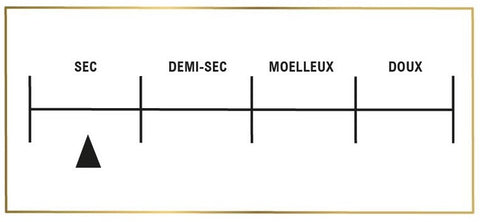Sweetness is one of the most important aspects in the balance of a wine, along with other factors such as acidity, alcohol and tannins. It can vary considerably from one wine to another, completely changing the tasting experience and our appreciation.
So that you may understand the difference between a sweet wine and a liqueur wine , here is an overview of the different types of wines, categorized according to their sugar level.
Dry wines
They represent the vast majority of wines produced in the world. They can be red , white , pink Or orange , never mind ! The only condition is that they must not exceed the 4g/L of residual sugars (i.e. 3g in a 75cl bottle). Suffice to say that at this dosage level, this is imperceptible when tasting .
Semi-dry wines
These wines have a slight sweetness in the mouth and their sweetness can vary between 4g and 12g/L (3g to 9g in a classic bottle). Generally, this dose of sugar is enough to give the wine a light delicacy and a tender side while maintaining a balanced character .
The majority of semi-dry wines are white ( Vouvray , Gewurztraminer etc.) but some rosés or red wines (rarer) can also fall into this category.
Sweet wines
Here the sugar level is even higher : between 12g and 45g/L (9g to 33.75g in a bottle). Tastewise, the aromas in this type of wine begin to turn towards candied fruits or honey and therefore express a great treat .
Once again, all the colours are there, although in reality, sweet white wines are the most common.
Sweet wines or liqueur wines
Finally, the category of sweet wines (or sweet) is at the top of this pyramid. Here we find the vintages containing more than 45g/L of residual sugars . Some wines can even reach 200g or even 300g/L. !
In France, when we think of sweet wine, Sauternes Bordeaux immediately comes to mind. However, the Late Harvest Or Selection of Noble Grains of Alsace , THE Natural Sweet Wines of Languedoc-Roussillon (AOC Maury and Banyuls in particular) as well as certain vintages from appellations such as Pacherenc of Vic-Bilh in the Southwest , Muscat of Rivesaltes or Muscat Beaumes-de-Venise in the Rhone Valley also fall into this category.
Here, Deliciousness and aromatic richness are essential (notes of candied fruit, honey, sweet spices etc.). Therefore, since sugar often takes precedence in terms of power in the dishes served, we generally open this kind of wines At dessert time .
However, the exotic and spicy cuisines can also pair wonderfully with sweet wines! Finally, we often mention foie gras as an ideal agreement.However, since it is generally enjoyed at the start of a meal, it would be preferable to opt for a semi-dry or sweet wine in order to and not saturate the palate with sugar from the start of the meal!
Conclusion
So you will have understood, the difference between a sweet wine and a liqueur wine is relative to the sugar level present in the wine, a liqueur being sweeter than a moelleux .
However, the notion of balance being essential in wine, a sweet wine with good acidity and complex aromas may seem less sweet in the mouth than some less well-constructed sweet wines. ! It is therefore important not to generalize and to discover for yourself all the subtleties of these wines. For this, do not hesitate to call on The Illuminated Cellar !

Wine sweetness scale



















